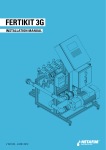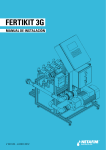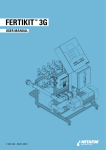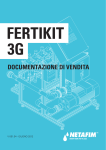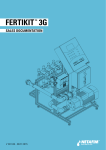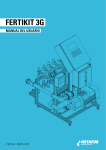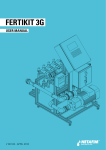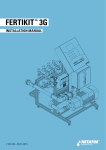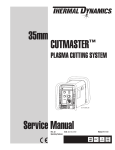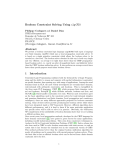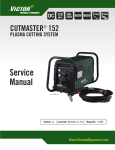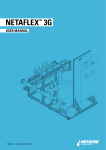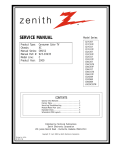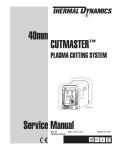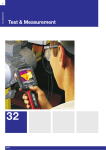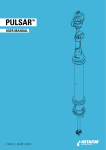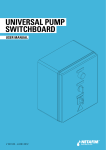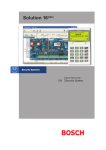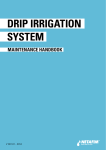Download the fertikit 3g
Transcript
FERTIKIT 3G SALES DOCUMENTATION V 001.07 - JUNE 2013 Use of symbols The symbols used in this manual refer to the following: WARNING The following text contains instructions aimed at preventing bodily injury or direct damage to the crops, the product and/or the infrastructure. CAUTION The following text contains instructions aimed at preventing unwanted system operation, installation or conditions that, if not followed, might void the warranty. ATTENTION The following text contains instructions aimed at enhancing the efficiency of usage of the instructions in the manual. NOTE The following text contains instructions aimed at emphasizing certain aspect of the operation of the system or installation. ACID HAZARD The following text contains instructions aimed at preventing bodily injury or direct damage to the crops, the product and/or the infrastructure in the presence of acid. TIP The following text provides clarification, tips or useful information. PROTECTIVE EQUIPMENT The following text contains instructions aimed at preventing damage to health or bodily injury in the presence of fertilizers, acid or other chemicals. © COPYRIGHT 2013, NETAFIM NO PARTS OF THIS PUBLICATION MAY BE REPRODUCED, STORED IN AN AUTOMATED DATA FILE OR MADE PUBLIC IN ANY FORM OR BY ANY MEANS, WHETHER ELECTRONIC, MECHANICAL, BY PHOTOCOPYING, RECORDING OR IN ANY OTHER MANNER WITHOUT PRIOR WRITTEN PERMISSION OF THE PUBLISHER. ALTHOUGH NETAFIM TAKES THE GREATEST POSSIBLE CARE IN DESIGNING AND PRODUCING BOTH ITS PRODUCTS AND THE ASSOCIATED DOCUMENTATION, THEY MAY STILL INCLUDE FAULTS. NETAFIM WILL NOT ACCEPT RESPONSIBILITY FOR DAMAGE RESULTING FROM THE USE OF NETAFIM'S PRODUCTS OR THE USE OF THIS MANUAL. NETAFIM RESERVES THE RIGHT TO MAKE CHANGES AND IMPROVEMENTS TO ITS PRODUCTS AND/OR THE ASSOCIATED DOCUMENTATION WITHOUT PRIOR NOTICE. FOREIGN LANGUAGES In the event that you are reading this manual in a language other than the English language, you acknowledge and agree that the English language version shall prevail in case of inconsistency or contradiction in interpretation or translation. CONTENTS The FERTIKIT 3G Description Advantages Specifications Mode selection diagram Basic functions Operating principle Modularity Service Maintenance Typical installation overview Add-ons 5 5 5 6 7 7 7 7 7 8 9 Selecting a FERTIKIT Introduction Hydraulic infrastructure Modes Venturis and dosing channels Electrical mains Dosing boosters EC/pH control Controllers Quick-Selection-Tool document 10 10 12 16 18 19 19 19 21 Installation requirements Infrastructure Electrical installation Flow rate stability Source water 22 24 24 24 Dimensions and weights Dimensions Weights Location of inlet, outlet and fertilizer/acid lines connectors Fertilizer/acid lines connection types Inlet and outlet connection types Safety and warranty Safety Warranty Appendices Appendix 1 Appendix 2 Appendix 3 Appendix 4 Appendix 5 Appendix 6 - 25 25 26 26 26 27 28 Dosing ratio estimates Performance curves for selection of the dosing booster Dosing booster list FERTIKIT summary of combinations List of configurator items On-line configurator 29 30 32 33 34 35 FERTIKIT SALES DOCUMENTATION 3 TABLES AND CHARTS/GRAPHS Tables 1 2 3 4 5 6 7 8 9 10 11 12 13 14 15 16 17 18 Venturis Dosing channels components for acid Matching the Venturis and the dosing channels The NMC controllers - Typical applications The NMC controllers - Features The NMC controllers - Software Infrastructure installation items Recommended flow meter FERTIKIT and package dimensions FERTIKIT weights with dosing booster FERTIKIT weights without dosing booster Fertilizers and acid lines connection types Inlet and outlet connection types Dosing ratio estimates Dosing booster list for 50 Hz installations Dosing booster list for 60 Hz installations FERTIKIT summary of combinations List of configurator items 17 17 18 20 20 21 23 24 25 25 25 26 26 29 32 32 33 34 Charts/Graphs 1 2 3 4 5 6 Operational pressure range Fertilizer injection capacity Performance curves - PL mode - 50 Hz Performance curves - PB mode - 50 Hz Performance curves - PL mode - 60 Hz Performance curves - PB mode - 60 Hz 4 FERTIKIT SALES DOCUMENTATION 6 6 30 30 31 31 THE FERTIKIT 3G Description The FERTIKIT 3G is a fully configurable fertilizer/acid dosing unit - a highly cost-effective solution for precise Nutrigation . Based on a standard platform, the FERTIKIT offers 4 different operation modes, selectable according to the site conditions, in order to maximize usage of available water flow rate and pressure on the main irrigation line, ensuring the highest efficiency with minimum investment. The FERTIKIT can accommodate a variety of dosing channels, dosing boosters, controllers, peripherals and accessories to meet a vast range of applications and infrastructure constraints. TM Advantages • A modular Nutrigation system for soil or substrate applications with minimum investment • Efficient usage of water, fertilizers and energy • Unrivaled range of irrigation water capacities • Designed for any application where quantitative or proportional Nutrigation is required • Highly profitable price/performance ratio • Venturi operating principle - no moving parts • Fits easily into any existing irrigation system • Precise Nutrigation based on high-accuracy dosing channels • Quick action dosing valves • Available with up to 6 fertilizer/acid dosing channels • Nutrigation recipes can be changed quickly and efficiently • Can be operated manually or fully computerized • NMC and other controllers can be assembled on the FERTIKIT for advanced Nutrigation control • A wide variety of accessories and peripherals can be integrated into the FERTIKIT to enhance its functions • High-quality components and PVC pipe work • Aluminum, corrosion-resistant frame with adjustable legs • Easy to install and to maintain • Made by Netafim TM TM TM TM TM Specifications Capacity range The FERTIKIT ensures a satisfactory mixture in an extremely vast range of flow capacities. Examples: It will accommodate a 0.1 Ha (0.25 Acres) nursery or a 400 Ha (1000 Acres) sugar cane plantation. To select a specific flow capacity consult the Selecting a FERTIKIT chapter, page 10. Fertilizer dosing capacity The FERTIKIT's basic platform accommodates up to 6 dosing channels of various types: • 50 l/hr (13 GPH) • 150 l/hr (40 GPH) • 400 l/hr (106 GPH) • 600 l/hr (158 GPH) • 1000 l/hr (265 GPH) * For applications requiring more than 6 dosing channels - consult netafim. FERTIKIT SALES DOCUMENTATION 5 THE FERTIKIT 3G Main line pressure range and conditions Typical main line pressure ranges and conditions, by mode: PD - For applications where there is sufficient pressure differentiation on the main line between the source pressure and the required pressure downstream from the FERTIKIT. PL - For applications where the main line pressure is between 2.5 and 6.5 bars (36-94 PSI) and sufficient for irrigation with no excess. PB - For applications where the main line pressure is between 1 and 2.5 bars (14.5-36 PSI) and sufficient for irrigation with no excess. MS - For applications where the pressure downstream the main line pump is between 1.5 and 8 bars (22-116 PSI). Mode selection diagram PD PB P1 P2 PL P1 Main line pressure can be reduced by 50% (P1 ≥ 2 X P2). P2 MS P1 P2 P1 Main line pressure is built up in a tank (P1 < P2). The system operates around the main line pump. Main line pressure is conserved (P1 = P2). P1 = Available pressure Operational pressure range P1 1) (Chart 0 20 40 60 80 100 l/hr 6000 GPH 1600 1000 260 600 160 100 PD 80 5 PL 60 4 3 40 2 PB 20 1 MS 1 2 3 4 5 6 7 8 Required main line pressure downstream from the FERTIKIT 6 FERTIKIT SALES DOCUMENTATION P2 0 -4.3 Maximum fertilizer injection capacity Available pressure upstream from the FERTIKIT (source) 120 PSI 120 7 0 -0.3 bars 0 P2 = Required pressure Fertilizer injection capacity (Chart 2) 8 6 P2 0 PD PB PL MS 0 THE FERTIKIT 3G Basic functions The FERTIKIT supports the following Nutrigation functions: • Fully controlled dosing and mixing of fertilizers/acid with source water into a homogenous nutrient solution. • EC/pH correction of the nutrient solution. • Water pre-treatment TM Operating principle The FERTIKIT doses the various fertilizers and acid into a homogeneous solution and injects it into the irrigation water main line. The suction of the fertilizers and acid in the dosing channels is based on the Venturi principle. This requires a pressure differentiation - available on the main line or supplied by the main line pump or the FERTIKIT's dosing booster. Modularity The modular FERTIKIT 3G concept is based upon an array of interchangeable components that enables rapid assembly of a wide range of configurations. Each FERTIKIT is delivered according to the precise customer’s order, either fully factory assembled or assembled by the local dealer. The dealer stocks the assortment of the FERTIKIT interchangeable components. This concept enables the dealer to assemble any specific FERTIKIT according to the customer’s order, saving the need to stock a large quantity of fully assembled FERTIKITs of various common configurations. The modular FERTIKIT 3G concept ensures prompt delivery schedules without delays! Service Servicing the FERTIKIT 3G is a prompt and simple process. The dealer keeps a small quantity of interchangeable components on hand, for replacement on site within a few minutes. Maintenance To prevent failures and extend the life cycle of the FERTIKIT, regular maintenance must be carried out by the user, such as periodic rinsing of filters and calibration of the EC/pH sensors. For full maintenance instructions, see Maintenance in the User Manual. FERTIKIT SALES DOCUMENTATION 7 THE FERTIKIT 3G Typical installation overview The drawing below represents the infrastructure suitable for the PB and PL modes. The infrastructure for the PD and MS modes is slightly different (see Installation requirements, page 22) FERTIKIT 3G Fertilizer/acid stock tank Pressure sustaining valve Main line pump Manual valve (fertilizer) Irrigation valve Pressure reducing valve Fertilizer/acid filter Water meter Manual valve (isolation) Main line filter 8 FERTIKIT SALES DOCUMENTATION THE FERTIKIT 3G Add-ons The FERTIKIT functionality can be extended by means of the many add-ons offering a wide variety of useful functions. All the add-ons are easy to connect to the FERTIKIT - here are a few examples: Fertilizer meter Enables continuous reading of fertilizer dosing. Useful in applications where EC/pH control is not performed. Anti-siphon valve Prevents gravitational flow of fertilizers to the main line when the system is idle. Head control A kit consisting of a water filter, a water meter and a main valve - installable on the main line, providing assigned connectors to the FERTIKIT's inlet and outlet, and assuring full integration with the FERTIKIT. Stock selection Enables the dosing of multiple fertilizers through a single dosing channel (in cases they where simultaneous dosing is not required). Available in a wide variety of configurations, from a single dosing channel with 2 fertilizers to as many dosing channels and fertilizers as required. For further information on the FERTIKIT add-ons, consult Netafim. FERTIKIT SALES DOCUMENTATION 9 SELECTING A FERTIKIT Introduction The FERTIKIT 3G can be incorporated in an existing or a planned project; in either case it offers a highly cost-effective solution for NutrigationTM by taking maximum advantage of the infrastructure conditions. Any available pressure surplus can be used for the FERTIKIT’s operation. In order to configure the most cost-effective FERTIKIT, making the maximum use of available pressure, follow the steps below. ATTENTION Calculations are either in metric or in US units - consistency in the type of units used is essential. ATTENTION Each mode can accommodate a specific range of Venturis - see Venturis table, page 17. Hydraulic infrastructure There are three basic types of hydraulic infrastructure. Identify the type of hydraulic infrastructure and select the appropriate mode of FERTIKIT: Type 1 - With main line pressure excess • There is sufficient pressure differentiation on the main line between the source pressure and the required pressure downstream from the FERTIKIT. • The pressure upstream from the PRV is at least twice the pressure downstream from the PRV (P1 ≥ 2 X P2). If these conditions are met - select the PD mode and save the cost of a dosing booster and its operating expenses. If not - proceed to type 2 below. P1 P2 Type 2 - No pressure excess on the main line • The maximum main line pressure is between 1 and 6.5 bars (14.5-94 PSI) • Main line pressure is sufficient for irrigation. • No main line pressure excess for the operation of the Venturis. • You tried the other types of hydraulic infrastructure, but they failed to meet the conditions for selecting the corresponding mode. ATTENTION If the pressure on the main line is under 1 bar (14.5 PSI) or over 6.5 bars (94 PSI), or if the maximum pressure on the main line is under 2.5 bars (36 PSI) and your installation requires 1000 l/hr (265 GPH) Venturis, consult Netafim. 10 FERTIKIT SALES DOCUMENTATION SELECTING A FERTIKIT • If the pressure on the main line is between 2.5 and 6.5 bars (36-94 PSI), select the PL mode. • If the pressure on the main line is between 1 and 2.5 bars (14.5-36 PSI), select the PB mode. Type 3 - With main line pump flow surplus • There is a pump on the main line. • It is possible to connect the FERTIKIT’s outlet upstream from the main line pump. • The main line pump capacity ≥ flow rate required for the field + TC (total consumption of the FERTIKIT). WARNING Measures must be taken to prevent fertilizer infiltration of the water source, to avoid water pollution. If these conditions are met - select the MS mode and save the cost of a dosing booster and its operating expenses. If not - proceed to type 2 above. Q pump Q field TC Q pump = Q field + TC FERTIKIT SALES DOCUMENTATION 11 SELECTING A FERTIKIT Modes PD For applications where there is sufficient pressure differentiation on the main line between the source pressure and the required pressure downstream from the FERTIKIT. Applicable also in cases where there is no electricity on the site. Can be controlled by a DC latch controller, fed by a 12 VDC battery with a solar panel. Saves the need for a dosing booster. Total fertilizer/acid suction capacity - up to 1000 l/hr (265 GPH) Accommodates a wide variety of dosing channels for fertilizer and concentrated/diluted acid: Up to 4 dosing channels, from 50 l/hr (13 GPH) each, up to 250 l/hr (66 GPH) each. Schematic diagram LEGEND scope of delivery direction of flow Irrigation valve Dosing channel + Venturi EC/pH transducer Water meter Upper manifold pressure gauge Fertilizer/acid stock tank Main line filter Lower manifold presure gauge Manual valve (fertilizer) Pressure reducing valve Controller Fertilizer/acid filter Sampling valve EC sensor Manual valve (isolation) Saddle fitting pH sensor Pressure sustaining valve Command tube 12 FERTIKIT SALES DOCUMENTATION SELECTING A FERTIKIT PL For applications where the main line pressure is between 2.5 and 6.5 bars (36-94 PSI) and is sufficient for irrigation with no excess. The pressure differentiation required to generate fertilizer suction via the Venturis is produced by a suction pump integrated in the Fertikit. This mode of operation, where the lower manifold is under low pressure (around 0 bar), permits the use of high-efficiency Venturis with high suction capacity and low consumption. Total fertilizer/acid suction capacity - up to 6000 l/hr (1585 GPH) Accommodates a wide variety of dosing channels for fertilizer and concentrated/diluted acid: Up to 6 dosing channels, from 50 l/hr (13 GPH) each, up to 1000 l/hr (265 GPH) each. Schematic diagram LEGEND scope of delivery direction of flow Dosing channel + Venturi Upper manifold pressure gauge Dosing booster Manual valve (isolation) Lower manifold presure gauge Dosing booster switchbox Pressure sustaining valve Sampling valve Check valve Irrigation valve Controller Pressure switch Water meter EC sensor Fertilizer/acid stock tank Main line filter pH sensor Manual valve (fertilizer) Main line pump EC/pH transducer Fertilizer/acid filter Pressure reducing valve FERTIKIT SALES DOCUMENTATION 13 SELECTING A FERTIKIT PB For applications where the main line pressure is between 1 and 2.5 bars (14.5-36 PSI) and is sufficient for irrigation with no excess. The pressure differentiation required to generate fertilizer suction via the Venturis is produced by a boost pump integrated in the Fertikit. This mode of operation, where the system pump is installed upstream from the Venturis, permits the use of a smaller pump, reducing the investment required and saving energy. Total fertilizer/acid suction capacity - up to 600 l/hr (158 GPH) Accommodates a wide variety of dosing channels for fertilizer and concentrated/diluted acid: Up to 4 dosing channels, from 50 l/hr (13 GPH) each, up to 150 l/hr (40 GPH) each. Schematic diagram LEGEND scope of delivery direction of flow Dosing channel + Venturi Upper manifold pressure gauge Dosing booster Manual valve (isolation) Lower manifold presure gauge Dosing booster switchbox Pressure sustaining valve Sampling valve Check valve Irrigation valve Controller Pressure switch Water meter EC sensor Fertilizer/acid stock tank Main line filter pH sensor Manual valve (fertilizer) Main line pump EC/pH transducer Fertilizer/acid filter Pressure reducing valve 14 FERTIKIT SALES DOCUMENTATION SELECTING A FERTIKIT MS For applications where there is a pump on the main line and it is possible to connect to the main line upstream from the pump. Saves the need for a dosing booster. Total fertilizer/acid suction capacity up to 6000 l/hr (1585 GPH) Accommodates a wide variety of dosing channels for fertilizer and concentrated/diluted acid: Up to 6 dosing channels, from 50 l/hr (13 GPH) each, up to 1000 l/hr (265 GPH) each. Schematic diagram LEGEND scope of delivery direction of flow Dosing channel + Venturi pH sensor Pressure sustaining valve Upper manifold pressure gauge EC/pH transducer Irrigation valve Lower manifold presure gauge Fertilizer/acid stock tank Water meter Sampling valve Manual valve (fertilizer) Main line filter Controller Fertilizer/acid filter Main line pump EC sensor Manual valve (isolation) FERTIKIT SALES DOCUMENTATION 15 SELECTING A FERTIKIT Venturis and dosing channels To accommodate a variety of infrastructures, flow rates and NutrigationTM needs, the FERTIKIT 3G offers a wide range of Venturis and dosing channels for fertilizer and acid. Typical Venturi and dosing channel Schematic diagram 1a Rotameter 1b Needle valve 1c Dosing valve 1d Check valve 1e Venturi Dual dosing channel If more than 4 dosing channels are required (up to 6), the dual dosing channel option can be used. • Up to 2 dual dosing channels can be installed on the FERTIKIT 3G, at the farthest manifold positions (1 and 4). • The dual dosing channel option is applicable with 600 l/hr (158 GPH) or 50 l/hr (13 GPH) Venturis. Schematic diagram LEGEND scope of the dual dosing channel direction of flow CAUTION There are fertilizer combinations that should never be used in the dual dosing channel as they will induce crystalization and cause clogging of the pipes. • Calcium Nitrate + Ammonium Sulfate => Calcium Sulfate • Calcium Nitrate + Potassium Sulfate => Calcium Sulfate • MKP + Calcium Nitrate => Calcium Phosphate • MAP + Calcium Nitrate => Calcium Phosphate • Phosphoric acid + Calcium Nitrate => Calcium Phosphate In case of doubt regarding the use of any combination of fertilizers in the dual dosing channel, consult your Netafim™ representative. 16 FERTIKIT SALES DOCUMENTATION SELECTING A FERTIKIT Venturis Table 1 - A complete line of Venturis is available to accommodate various flow rates of fertilizer or acid. Venturi PVDF - M050 PP - N150 PP - M250 PVC - N600 PVC - N1000 Applicable for mode Any mode Any mode PB / PD PL / MS PL / MS Nominal flow l/hr (GPH) 50 (13) 150 (40) 250 (65) 600 (158) 1000 (265) Typical consumption* m 3 /hr (GPM) 1 (4.4) 1.2 (5.3) 4 (17.5) 1.2 (5.3) 4 (17.5) Maximum # of Venturis** 4 4 4 6 6 * Consumption = the flow of water that needs to pass through the Venturi to enable nominal suction. ** If a combination of Venturis of different sizes is required, consult Netafim. Dosing channels ATTENTION Table 2 - When dosing acid, use a dosing channel fitted with the appropriate components according to the type and concentration of the acid used*: Nitric (HNO3 ) Phosphoric (H 3 PO4 ) Sulfuric (H2SO4 ) Hydrochloric (HCl) Hydrogen peroxide (H2O2 ) Chlorine (as hypochloride) Type of dosing channel For diluted acid For concentrated acid For maintenance of drippers Diaphragm and O-rings For pH correction EPDM Viton <3% <40% <85% <85% <30% <90% <10% <33% <30% <50% <1% <10% % is by weight at 21oC (70oF) * The table indicates the resistance of the dosing channel components to acid, and is not a recommendation to use the acids mentioned. WARNING Exceeding the recommended acid concentrations will damage the dosing channels. Dosing channels for fertilizer or diluted acid Capacity - l/hr (GPH) • 150 (40) • 400 (106) • 600 (158) • 1000 (265) Each of the above dosing channels is available in any of the following options: • AC 50 or 60 Hz - according to the electricity frequency. • Manual - for applications without a controller. • Hydraulic - for DC latch applications. • Bio - for applications with high viscosity organic fertilizers, enabling controlled flushing after each irrigation shift. Dosing channel for concentrated acid Capacity - 50 l/hr (13 GPH). AC 50 or 60 Hz - according to the electricity frequency. FERTIKIT SALES DOCUMENTATION 17 SELECTING A FERTIKIT Compute the fertilizer flow rate To select the appropriate fertilizer dosing channels and Venturis, perform the following calculation: Enter the flow rate of the largest irrigation shift Enter the dosing ratio of a single fertilizer (for guidelines see appendix 1, page 29) Result: a single fertilizer flow rate Metric units m3 /hr X l/m 3 = l/hr US units GPM X US gal/1000 US gal X 0.06 = GPH Matching the Venturis and the dosing channels Table 3 - Use the table below to formulate the appropriate combination of Venturis and dosing channels. Dosing channel nominal capacity l/hr (GPH) 50 (13) concentrated acid 50 (13) 150 (40) 400 (106) 600 (158) 1000 (265) Venturi PVDF - M050 PP - N150 PP - M250 PVC - N600 + + + + PVC - N1000 + + + + ATTENTION The maximum fertilizer/acid suction capacity of the dosing channel–Venturi combination is limited to their lowest-capacity component. The actual fertilizer/acid suction capacity depends on the actual pressure conditions on site. Compute the FERTIKIT’s total consumption (TC) In order to assess the applicability of the MS mode or to identify the correct dosing booster needed for PB or PL mode application, it is necessary to know the FERTIKIT’s total consumption of water (TC). The FERTIKIT’s total consumption (TC) is the sum of the typical consumption of all the selected Venturis (fertilizers and acid) - see table 1, page 17. Electrical mains To select the proper dosing channels, dosing booster, controller and accessories, it is essential to know the properties of the electricity on site. The electricity frequency (Hz) and voltage (V) depends on the country (in some countries frequencies and voltages differ by area). NOTE In cases where three-phase electricity is supplied in addition to a single phase, take note: • The controller is single phase. • In most cases, a three-phase dosing booster is preferable. TIP If there is no electricity on site, check the possibility of operating under the PD mode fed by a 12 VDC battery (solar panel - optional), consult Netafim. 18 FERTIKIT SALES DOCUMENTATION SELECTING A FERTIKIT Dosing boosters To select the dosing booster, consult the appropriate graph in appendix 2 - performance curves. Consult the appropriate graph according to the electricity frequency on the site (50 Hz - p. 30) (60 Hz - p. 31) and the mode you selected - PB or PL only (PD and MS do not require a dosing booster). Identify the performance curve where the pressure corresponding to the FERTIKIT’s total consumption (TC) is equal to or greater than the maximum main line pressure, and select the appropriate dosing booster. ATTENTION Make sure that the selected dosing booster fits the electricity voltage, phases and frequency on site. EC/pH control In case of flow variations, the EC/pH control set enables the controller to perform precise fertilizer/acid optimization. There are 2 types of sets: • Compatible with the NMC junior or the NMC Pro controllers. • Compatible with the NMC XL controller via the FertMaster* terminal unit (for further details, consult Netafim). • For other options, consult netafim. *FertMaster is the terminal unit of the NMC XL controller, used when EC/pH measurment is needed on the FERTIKIT and the NMC XL is used as an outboard controller. As a standalone, it also offers the capacity to control the FERTIKIT's dosing channels and system pump a cost-effective solution where the FERTIKIT is used to fill a solution tank. Controllers The FERTIKIT can be controlled by a variety of NMC controllers, offering many useful functions. • The NMC Junior is the affordable option for small applications. • The NMC Pro is the solution for mid-range to large applications. • The NMC XL is the solution for mid-range to large applications where a single controller controls multiple dosing units, there are multiple main lines or water meters, or any of the many NMC XL exclusive features are required (consult Netafim). • The NMC DC is the option for applications where there is no electricity (consult Netafim). • In cases where the FERTIKIT is to be connected to another type of controller, consult Netafim. ATTENTION Many parameters should be considered in selecting a controller for the FERTIKIT, depending on various factors such as, operating method, size of the field, and many more. A comprehensive discussion on selecting a controller is beyond the scope of this document (see the NMC controllers documentation or consult Netafim). FERTIKIT SALES DOCUMENTATION 19 SELECTING A FERTIKIT The NMC controllers Table 4 Typical application Large-scale open field NMC-Junior NMC-Pro NMC-XL NMC-DC + Medium-scale open field + + Greenhouse on soil + + Greenhouse on soilless + + + Table 5 Features NMC-Junior NMC-Pro NMC-XL up to 15 up to 256 up to 250 Digital outputs, 24 VAC Digital outputs, DC latch NMC-DC up to 24 Irrigation programs 15 15 120 15 External condition programs 15 15 120 15 ET (evapo-transpiration) trigger for irrigation Maximum number of valves in the system Maximum number of valves running simultaneously Maximum number of dosing programs running in parallel Yes Type of output, 24 VAC 15 255 250 24 15 40 30 per program 24 1 1 1 per line 1 Relay Relay Triac Latch Dry contact outputs Yes Number of digital inputs 6 32 250 4 Number of analog inputs 5 22 99 4 RadioNet valve control (RTU) Yes Yes Yes SingleNet valve control (RTU) Yes Yes Yes Misting program by time Yes Yes Yes Yes Cooling program by temperature/humidity Maximum number of supply pumps Yes Yes With condition program Yes 6 6 36 6 (not simultaneously) (not simultaneously) 6 128 (not simultaneously) Master flow meters 3 6 100 6 Auxiliary flow meters 6 8 100 8 Fertilizer flow meters 6 8 6 (per station) 8 Yes Yes Yes Maximum number of main lines 3 Control by pressure transducer 6 Filter flushing - number of filters 14 24 100 24 Fertilizer programs 10 10 120 10 20 FERTIKIT SALES DOCUMENTATION SELECTING A FERTIKIT Table 6 Software NMC-Junior NMC-Pro NMC-XL NMC-DC Controller languages English, Spanish, Italian, Japanese, French, Russian, German, Korean, Chinese Group A (default) English, Spanish, Italian, Japanese, German, French, Turkish, Dutch English, Spanish, Italian, Turkish, Russian Group A (default) English, Spanish, Italian, Japanese, German, French, Turkish, Dutch Group B English, Russian, Greek, Serbian, Hungarian, Polish Group B English, Russian, Greek, Serbian, Hungarian, Polish Updated - January 2012 General guidelines to help you select a controller Select the basic configuration of the controller according to the number of AC outputs required to control all AC irrigation valves and local devices (the FERTIKIT's internal devices - dosing channels and dosing booster, and the local devices in the pump house - filter flushing, main line pumps, main line valves, etc.). Select the connectivity to remote units If there are DC latch* irrigation valves, select the connectivity type according to the type of the remote units (SingleNet** or RadioNet***) with the license key that accommodates the number of remote units (up to 128 or up to 256). *DC latch is the operating principle of a switch fed by 12 VDC, where an electrical pulse toggles between the on and off states. It is used in irrigation valves and hydraulic operation valves. **SingleNet is a remote operation method to open/close DC latch valves via a 2-wire cable. ***RadioNet is a remote operation method to open/close DC latch valves via wireless transmission (radio frequency). Select the PC communication NOTE The above SingleNet and RadioNet options include various PC communication capabilities (for further details, consult Netafim). Wired or wireless, the NMC PC communication offers many convenient features: • Enables remote access for service and consultation. • Enables data logging. • Comfortable interface. Additional controller accessories • Power line protector • Temperature and humidity measuring box • Weather station For further details, consult Netafim. • Radiation sensor • Communication card • Communication (MUX) • Cellular modem Quick-Selection-Tool document In order to facilitate the proccess of configuring the FERTIKIT and issuing a price estimate, we make available the FERTIKIT Quick-Selection-Tool - a concise, easy-to-use document, enabling the configuration of the appropriate FERTIKIT in 5 easy steps, according to the infrastructure and the NutrigationTM needs. (To receive the Quick-Selection-Tool and instructions for using it, call Netafim.) The installation should be performed according to the requirements detailed in the FERTIKIT installation manual. FERTIKIT SALES DOCUMENTATION 21 INSTALLATION REQUIREMENTS Infrastructure • The distance between the inlet and the outlet of the FERTIKIT on the main line should be from 2 to 4 meters. • Sufficient space should be available between the fertilizer/acid tanks and the FERTIKIT to allow inspection and maintenance operations. Installation for PD mode • The pressure on the main line upstream from the PRV should be at least twice the pressure downstream from the PRV. Installation for PB and PL modes *see legend - table 7, p. 23 • In PL mode, the pressure on the main line should be minimum 2.5 bars *see legend - table 7, p. 23 22 FERTIKIT SALES DOCUMENTATION INSTALLATION REQUIREMENTS Installation for MS mode Infrastructure installation items Table 7 Item Specifications Fertilizer/acid stock tank Between 1 and 6 fertilizer/acid solution stock tanks Manual valve (fertilizer) A manual ball valve on each fertilizer/acid line at the stock tank outlet Fertilizer/acid filter ≤ 130 µm (≥ 120 mesh) To be installed at the inlet and at the outlet of the FERTIKIT, for use during system maintenance. To be installed on the main line downstream from the FERTIKIT and able to sustain a constant pressure at the intake of the FERTIKIT, regardless of pressure changes in the field. Should be calibrated to 3-4 bars (43-58 PSI) for most projects. Manual valve (isolation) Pressure sustaining valve (PSV) Irrigation valve Water meter Controllable. With electrical pulses. The pulse should be as short as possible according to the main line diameter and the controller's limitations. (See Recommended flow meter, table 8, page 24.) Main line filter ≤ 130 µm (≥ 120 mesh). Suitable for the required pressure and flow rate according to the mode of Main line pump the FERTIKIT and the field requirements (Ensure stable pressure). Pressure reducing valve In the PB or PL mode - Should be installed on the main line, between the main line filters and the water meter and be able to reduce the main line (PRV) pressure as specified for PL or PB modes (pages 13-14). In PD mode only - Should be installed on the main line, between the inlet and the outlet of the FERTIKIT and be able to reduce the main line pressure as specified for the PD mode (page 12). In PD mode only - Should be installed on the main line, downstream from Sampling valve the FERTIKIT's outlet (in all other modes the sampling valve is built-in). In PD mode only - Should be installed on the main line, downstream from the Saddle fitting FERTIKIT's outlet, equipped with an outlet suitable for the EC/pH sampling tube. FERTIKIT SALES DOCUMENTATION 23 INSTALLATION REQUIREMENTS Recommended flow meter Table 8 Flow rate m 3 /hr Up to 6 6 - 60 60-600 Flow meter output l/pulse 1 10 100 Flow rate GPM Up to 88 88 - 1000 1000-4500 Flow meter output US gal/pulse 1 10 100 Electrical installation An electrical mains installation including a circuit breaker, complying with the local safety standards and regulations should be supplied in acordance with the FERTIKIT's power consumption requirements. FERTIKIT's power consumption (kW) • All FERTIKIT configurations without a dosing booster (PD or MS modes) consume under 150 W. • In PB or PL modes, the FERTIKIT's total power consumption depends mainly on the consumption of the dosing booster (see appendix 3 - Dosing booster list, page 32). Flow rate stability Ensure that the consumption of the individual irrigation shifts is as equal as possible. Each changeover between shifts with different consumption will result in consumption fluctuation, affecting the EC and pH stability. The smallest shift should not be less than 75% of the largest shift. Source water • Source water should be available at sufficient flow and pressure. If the water pressure at the inlet of the FERTIKIT is insufficient, the minimum pressure protection switch will be activated and the fertilizer solution supply will be interrupted. • The water entering the FERTIKIT should be within a temperature range of 10°C and 35°C (50°F and 95°F). • The source water to the FERTIKIT should be of a satisfactory chemical quality. If water pre-treatment is required, apply chemical conditioning before the water reaches the FERTIKIT. Source water quality A good quality of source water, with a bicarbonate (HCO3 ) content of less than 5.0 meq/l (19 meq/US gal), can be used in the FERTIKIT in combination with pH control and an acid dosing channel. Excess bicarbonate - 5.0 meq/l (19 meq/US gal) or higher - should be removed from the source water before it enters the FERTIKIT to avoid creation of low-solubility salts in the solution. This is achieved by acidifying the incoming water to a mild acid pH value of approx. 6.0 prior to its storage in a day storage tank. This process can be performed by an additional FERTIKIT fitted with the appropriate features. The acid will neutralize the bicarbonate in the storage tank by means of a chemical reaction and the carbon dioxide (CO2 ) will be released from the source water. Aerating or spraying the water will improve the discharge of CO2, accelerating the neutralization process. Neutralization of the source water is necessary to create a stable pH in the FERTIKIT. Well water, mains water and river water may contain high bicarbonate concentrations - 5.0 meq/l (19 meq/US gal) or higher - necessitating the application of the above neutralization process. NOTE A full analysis of the water is recommended. In case of doubt, consult a Netafim expert. 24 FERTIKIT SALES DOCUMENTATION DIMENSIONS AND WEIGHTS Dimensions Without controller H H With controller W W D D Table 9 Configuration Without controller With controller FERTIKIT external dimensions (W/D/H*) Package dimensions (W/D/H**) 84/103/92 cm (33/40.5/36") 100/115/100 cm (39.5/45.5/39.5") 84/103/134.5 cm (33/40.5/53") 100/115/161 cm (39.5/45.5/63.5") *The height varies by ±1 cm (±0.5") according to the adjustment of the legs. **The package height includes the pallet height of 15 cm (6"). Weights° Table 10 - With dosing booster°° 4HM9 Mode Controller PB or PL Without With Net weight 50 kg. (110 lbs.) 60 kg. (132 lbs.) CM5 Packed weight 75 kg. (165 lbs.) 88 kg. (194 lbs.) Net weight 63 kg. (139 lbs.) 73 kg. (161 lbs.) Packed weight 88 kg. (194 lbs.) 101 kg. (223 lbs.) CM15 Net weight 90 kg. (198 lbs.) 100 kg. (220 lbs.) Packed weight 115 kg. (254 lbs.) 128 kg. (282 lbs.) °°Dosing boosters regularly in stock - for the weight of FERTIKITs with other dosing boosters, consult Netafim. Table 11 - Without dosing booster Mode Controller PD Without or With MS Net weight Packed weight 33 kg. (73 lbs.) 58 kg. (128 lbs.) 43 kg. (95 lbs.) 71 kg. (157 lbs.) °Order of magnitude only - final weights will be issued with the product order. FERTIKIT SALES DOCUMENTATION 25 DIMENSIONS AND WEIGHTS Location of inlet, outlet and fertilizer/acid line connectors PD, PL and MS modes PB mode Inlet Outlet 20.4 cm (8") 45.5 cm* (17.9") 11.4 cm 11.4 cm 11.4 cm (4.5") (4.5") (4.5") fertilizer/acid lines connectors 12.5 cm* (4.9") 12.5 cm* (4.9") fertilizer/acid lines connectors 20.4 cm (8") 11.4 cm 11.4 cm 11.4 cm (4.5") (4.5") (4.5") 75 cm (29.5") 75 cm (29.5") *The height varies by ±1 cm (±0.5") according to the adjustment of the legs. Fertilizer and acid line connection types Table 12 Diameter Fittings (interchangeable) PVC, hose nozzle insert connector (installed) 16 mm PVC, nipple - male thread connector (supplied) 1/2" PVC, half union - female thread connector (supplied) 3/4" Inlet and outlet connection types Table 13 Fittings (interchangeable) PVC, adaptor union - glue connector (installed) Diameter PVC, BSP or NPT nipple - male thread connector (supplied) 1.5" 26 FERTIKIT SALES DOCUMENTATION 50 mm 25.5 cm* (10") Outlet Inlet SAFETY AND WARRANTY Safety • All safety regulations must be applied. • Ensure that the installation is carried out in a manner that prevents leaks from the FERTIKIT, the fertilizer/acid tanks and lines, the peripherals and the accessories (contaminating the environment, soil or ambient area). • When using acid always observe the acid manufacturer's safety instructions. • Use protective equipment, shoes, gloves and goggles when handling fertilizers, acid and other chemicals! • Electrical installation should be performed by an authorized electrician only. • The electrical installation must comply with the local safety standards and regulations. • Installation should be performed by authorized technicians only. • Protection provided by the equipment can be impaired if the equipment is used in a manner other than that specified by the manufacturer. ACID HAZARD When using acid - always observe the acid manufacturer's safety instructions. WARNING Always use protective equipment, gloves and goggles when handling fertilizers, acid and other chemicals! WARNING Measures must be taken to prevent fertilizer infiltration of the water source, to avoid water pollution. NOTE The maximum sound level produced by the equipment does not exceed 70dB. FERTIKIT SALES DOCUMENTATION 27 SAFETY AND WARRANTY Warranty Netafim warrants all the components of the FERTIKIT to be free of defects in material and workmanship for 1 (one) year from the date of installation, provided the installation has been reported to Netafim within 30 days of installation. If the installation was not reported or was reported later than 30 days from the date of installation, Netafim will warrant the FERTIKIT for a period of 18 months from the date of production, according to its serial number. If a defect is discovered during the applicable warranty period, Netafim will repair or replace, at its discretion, the product or the defective part. The above does not apply to EC and pH sensors, since they are wearable. Netafim will warrant these items to be free of defects in material and workmanship for 3 months from the date of installation, provided the installation has been reported to Netafim within 30 days, or 6 months from date of production if installation was not reported or was reported later than 30 days from the date of installation. NOTE When not installed, the pH sensor must be immersed in KCL solution at all time, protected from freezing and not be exposed to pressure greater than 7 bars (100 PSI). Damage due to these causes is not covered by warranty. This warranty does not extend to repairs, adjustments or replacements of a FERTIKIT or part that results from misuse, negligence, alteration, force majeure, lightning, power surge, improper installation or improper maintenance. If a defect arises in your Netafim product during the warranty period, contact your Netafim supplier. Limited Warranty This warranty is subject to the conditions in Netafim's official warranty statement. (For the full text of Netafim's official warranty statement, please contact Netafim). 28 FERTIKIT SALES DOCUMENTATION APPENDIX 1 Dosing ratio estimates WARNING These are only estimates - for the exact fertilizer dosing ratio in a given project, consult an agronomist. Table 14 Irrigation according to the water consumption of the crop Crop Open Field Carrot Corn / Maize Cotton Flowers Industrial tomato Onion Plantations (Tea, coffee, citrus, avocado, almonds, pecan nuts) Potato Sorghum Sugar cane Vegetables Watermelon Protected Crops Vegetable in soil (A+B+acid) Flowers in soil (A+B+acid) Vegetable in soil (A+B+C+D+acid) Flowers in soil (A+B+C+D+acid) Vegetable in substrate Flowers in substrate Vegetable in substrate (High-Tech greenhouse - Multi-pulse**) Flowers in substrate (High-Tech greenhouse - Multi-pulse**) Dosing ratio per channel (l/m3 ) (US gal/1000 US gal) Type 1 1 2 2 3 1 2 1 1 Type 2 2.5 5 5 5 2.5 5 2.5 2.5 1 1.5 3 1 2.5 3 5 2.5 5 5 3.5 3.5 5 5 10 10 Type 1: Normal irrigation/nutrigation - Usually out of the rainy season, where a lower fertilizer dosing ratio is required. Type 2: Technical Nutrigation - Usually during rainy seasons, where a small quantity of irrigation water is required for application of the fertilizer. FERTIKIT SALES DOCUMENTATION 29 APPENDIX 2 Performance curves for selection of the dosing booster - 50 Hz Typical consumption of Venturis Table 1 - A complete line of Venturis is available to accommodate various flow rates of fertilizer or acid. Applicable Nominal flow Typical consumption* Venturi for mode l/hr (GPH) m 3 /hr (GPM) PVDF - M050 Any mode 50 (13) 1 (4.4) PP - N150 Any mode 150 (40) 1.2 (5.3) PP - M250 PB / PD 250 (65) 4 (17.5) PVC - N600 PL / MS 600 (158) 1.2 (5.3) PVC - N1000 PL / MS 1000 (265) 4 (17.5) * Consumption = the flow of water that needs to pass through the Venturi to enable nominal suction. PL mode (Graph 3) PSI bars 130 9 120 8 110 100 Main line pressure 90 7 CM25-4 CM10-8 6 80 70 60 5 CM15-4 4 CM10-5 50 40 30 CM10-6 CM5-9 CM10-4 2 4HM9 CM10-3 20 10 0 CM15-3 CM5-7 3 1 0 0 0 1 5 2 3 10 4 15 5 20 6 25 7 8 9 30 35 40 PB mode (Graph 4) 10 11 45 50 12 13 55 14 60 15 65 FERTIKIT total consumption (TC) 16 70 17 75 18 80 PSI bars 90 6 80 Main line pressure 70 60 5 CM15-3 4 CM10-3 50 40 30 4HM9 3 2 20 10 0 1 0 0 0 1 5 2 10 3 4 15 5 20 6 25 7 8 9 30 35 40 10 45 11 50 12 13 55 FERTIKIT total consumption (TC) 30 FERTIKIT SALES DOCUMENTATION 14 60 15 65 16 70 17 m3/hr 75 GPM 19 85 20 21 90 22 m3/hr 95 GPM LEGEND • The heavy-line curves represent the dosing boosters regularly in stock, enabling a shorter delivery time. • The white areas in the graphs represent the operational pressure range of each mode. • The gray areas in the graphs represent the pressure range at which the operation is not recommended. APPENDIX 2 Performance curves for selection of the dosing booster - 60 Hz Typical consumption of Venturis Table 1 - A complete line of Venturis is available to accommodate various flow rates of fertilizer or acid. Applicable Nominal flow Typical consumption* Venturi for mode l/hr (GPH) m 3 /hr (GPM) PVDF - M050 Any mode 50 (13) 1 (4.4) PP - N150 Any mode 150 (40) 1.2 (5.3) PP - M250 PB / PD 250 (65) 4 (17.5) PVC - N600 PL / MS 600 (158) 1.2 (5.3) PVC - N1000 PL / MS 1000 (265) 4 (17.5) * Consumption = the flow of water that needs to pass through the Venturi to enable nominal suction. PL mode (Graph 5) PSI bars 130 9 120 8 110 100 Main line pressure 90 7 6 70 60 5 CM5-6 CM10-4 4 CM15-2 50 40 30 CM10-3 3 CM5-4 CM10-2 2 20 10 0 4HM96 1 0 0 0 1 5 2 3 10 4 15 5 20 6 25 7 8 9 30 35 40 PB mode (Graph 6) 10 11 45 50 12 13 55 14 60 15 65 FERTIKIT total consumption (TC) 16 70 17 75 18 80 PSI bars 90 6 80 Main line pressure 70 60 5 CM15-2 4 CM10-2 50 40 30 4HM96 3 2 20 10 0 CM15-3 CM10-5 80 1 0 0 0 1 5 2 10 3 4 15 5 20 6 25 7 8 9 30 35 40 10 45 11 50 12 13 55 FERTIKIT total consumption (TC) 14 60 15 65 16 70 17 m3/hr 75 GPM 19 85 20 21 90 22 m3/hr 95 GPM LEGEND • The heavy-line curves represent the dosing boosters regularly in stock, enabling a shorter delivery time. • The white areas in the graphs represent the operational pressure range of each mode. • The gray areas in the graphs represent the pressure range at which the operation is not recommended. FERTIKIT SALES DOCUMENTATION 31 APPENDIX 3 Dosing booster list • The dosing boosters in bold characters are regularly in stock, enabling a shorter delivery time. For 50 Hz installations For 60 Hz installations Table 15 Table 16 Phases 1 3 Dosing booster FERTIKIT's total power consumption (kW) 4HM96 1.25 4HM96/110 1.25 CM5-4 1.29 2.05 4HM96T 1.25 4HM9T 1.63 CM5-4 1.85 CM5-7 1.73 CM5-6 2.65 CM5-9 2.35 4.15 CM10-3 2.35 CM10-4 220-240/ CM10-5 380-415 CM10-6 3.35 CM10-2 208-230/ CM10-3 440-480 CM10-4 6.35 3.35 CM10-5 6.35 4.15 CM15-2 4.15 CM10-8 5.95 CM15-3 6.35 CM15-3 4.15 CM15-4 5.95 CM25-4 7.55 Volts 220-240 Dosing booster FERTIKIT's total power consumption (kW) 4HM9 1.63 CM5-7 1.45 CM5-9 2.05 CM10-3 32 FERTIKIT SALES DOCUMENTATION Phases 1 Volts 110-120 220-240 3 4.15 MS 1 - 2.5 bars (14.5-36 PSI) and sufficient for irrigation with no excess. PB The pressure differentiation required to generate fertilizer suction via the Venturis is produced by a boost pump integrated in the Fertikit. This mode of operation, where the system pump is installed upstream from the Venturis, permits the use of a smaller pump, reducing the investment required and saving energy. This mode is suitable for relatively low flow-rates. Utilizes the main line pump pressure. Saves the need for a dosing booster. 2.5 - 6.5 bars (36-94 PSI) The pressure differentiation required and sufficient for irrigation to generate fertilizer suction via the Venturis is produced by a suction pump with no excess. integrated in the Fertikit. This mode of operation, where the lower manifold is under low pressure (around 0 bar), permits the use of high-efficiency Venturis with high suction capacity and low consumption. PL Pressure downstream the main line pump: 2 - 8 bars (29-116 PSI) and possibility of connection to the main line upstream from the pump. The main line pump capacity ≥ Q of the largest shift + TC at the required pressure for irrigation. There is sufficient pressure differentiation between the source pressure and the required pressure downstream from the FERTIKIT. The pressure upstream from the PRV is at least twice the pressure downstream from the PRV. Utilizes the main line pressure. Applicable also where there is no electricity on the site (consult Netafim). Saves the need for a dosing booster. PD Main line pressure - bar (PSI) and flow conditions Operating principle Mode 400 (106) PP - M250 250 (65) PVC - N1000 1000 (265) 50 (13), 150 (40) 150 (40), 400 (106), 600 (158) 1000 (265) 400 (106) 50 (13), 150 (40) PP - N150 150 (40) PP - M250 250 (65) PP - N150 150 (40) PVC - N600 600 (158) 50 (13) Concentrated acid 50 (13) Concentrated acid 50 (13), 150 (40) 150 (40), 400 (106), 600 (158) 1000 (265) 400 (106) l/hr (GPH) 50 (13) Concentrated acid 50 (13), 150 (40) Dosing channel capacities PVC - N1000 1000 (265) PVDF - M050 50 (13) PVDF - M050 50 (13) PP - N150 150 (40) PVC - N600 600 (158) PP - M250 250 (65) Nominal flow l/hr (GPH) PVDF - M050 50 (13) PP - N150 150 (40) Venturis APPENDIX 4 FERTIKIT summary of combinations Table 17 FERTIKIT SALES DOCUMENTATION 33 APPENDIX 5 List of configurator items Table 18 F 3 PL -3 U 4 0 +1 SA05 -5 0H 4 0 0 CM5 9 EH -24 P2 4 85 FM A B A C D E FERTIKIT 3G B Mode Code PL PB MS PD IL SP C Description PL PB MS PD IL Split G H Code -0 -1 -2 -3 -4 -5 -6 Description No channel for fertilizer 1 channel for fertilizers 2 channels for fertilizers 3 channels for fertilizers 4 channels for fertilizers 5 channels for fertilizers 6 channels for fertilizers D Dosing channel operator Code Blank E U H M CF Description No channel for fertilizer Electric (standard) Electric (S12) Hydraulic (24 V DC solenoid) Manual Electric - comcentrated fertilizer Code D60 D40 D25 D15 D05 SA05 SA15 CA05 CA15 Blank Code 100 60 40 25 15 05 Blank Description 1000 l/h (264 GPH) 600 l/h (158 GPH) 400 l/h (105 GPH) 250 l/h (66 GPH) 150 l/h (40 GPH) 50 l/h (13 GPH) No channel for fertilizer No of acid channels Code Blank +1 +2 +3 +4 +5 +6 Description No channel for acid 1 channel for acid 2 channels for acid 3 channels for acid 4 channels for acid 5 channels for acid 6 channels for acid J H Frequency Code -50H -60H Blank I Description 50Hz 60Hz No frequency (DC or manual) Voltage Code 12VDC 12VAC 400 440 220 200 1X220 1X110 Blank Description 12 VDC 12 VAC 3 x 380 - 415 V 3 x 400 - 440 V 3 x 220 V 3 x 200 V 1 x 220 V 1 x 110 V Manual J Pump type Code -4HM9 CM54 CM56 CM57 CM59 CM102 CM103 CM104 CM105 CM106 CM108 CM152 CM153 CM154 CM254 Blank Description Lowara 4HM9 Grundfos -CM5-4 Grundfos -CM5-6 Grundfos -CM5-7 Grundfos -CM5-9 Grundfos -CM10-2 Grundfos -CM10-3 Grundfos -CM10-4 Grundfos -CM10-5 Grundfos -CM10-6 Grundfos -CM10-8 Grundfos -CM15-2 Grundfos -CM15-3 Grundfos -CM15-4 Grundfos -CM25-4 No pump 34 FERTIKIT SALES DOCUMENTATION K L Description Diluted acid 600 l/h (158 GPH) Diluted acid 400 l/h (105 GPH) Diluted acid 250 l/h (66 GPH) Diluted acid 150 l/h (40 GPH) Diluted acid 50 l/h (13 GPH) Concentrated acid 50 l/h (13 GPH) S12 Concentrated acid 150 l/h (40 GPH) S12 Concentrated acid 50 l/h (13 GPH) Concentrated acid 150 l/h (40 GPH) No channel for acid Fertilizer channel flowrate E I G Acid channel No of fertilizer channels (Fertilizer only, excluding acid) F F L M N O Number of outputs Code -8 -15 -16 -24 -32 -40 -48 -56 -64 Blank Description 8 outputs 24V AC (For FertMaster) 15 outputs 24V AC (Junior) 16 outputs 24V AC 24 outputs 24V AC 32 outputs 24V AC 40 outputs 24V AC 48 outputs 24V AC 56 outputs 24V AC 64 outputs 24V AC Without controller M Controller Code JC2 JK2 J1 J2 J3 J4 P1 P2 K2 K4 P3 P4 DC -F1 -F2 -SSR Blank Description NMC-Junior 230V Chinese NMC-Junior 230V Korean NMC-Junior 115V NMC-Junior 230V NMC-Junior 115V - Double Door NMC-Junior 230V - Double Door NMC-Pro 115V NMC-Pro 230V NMC-Pro 230V - Koren & Chinese NMC-Pro 230V - Koren & Chinese - Double Door NMC-Pro 115V - Double Door NMC-Pro 230V - Double Door NMC DC FertMaster 115 V FertMaster 230 V Solid state relays for the dosing channel (no controller) Without controller N Communication port Code -485 -EXP -232 -SN1 -SN2 -128 -256 -GSM Blank Description RS-485 (parallel) communication card Dual RS485 for expansion box RS-232 (serial) communication card SingleNet with license key 128 (Including host* & SLSM**) SingleNet with license key 256 (including host* & SLSM**) RadioNet with license key 128 (excluding host*) RadioNet with license key 256 (excluding host*) GSM modem onboard None *Host: Interface card between the NMC Pro and SingleNet **SLSM: SingleNet Lightning Suppression Module K EC/pH measurement O Special configuration Code EH EC PH Blank Code -FM -FG Blank Description EC/pH EC pH None Description Fertilizer meters - Litres Fertilizer meters - Gallons None APPENDIX 6 On-line configurator To receive a quote or find the catalogue Number for a selected FERTIKIT configuration after selecting the FERTIKIT, go to www.netafim.com In the on-line configurator: • Follow the instructions • Send the resulting string to Netafim. ATTENTION Not every configuration of the FERTIKIT is practicable. Do not use the List of configurator items on the previous page to build a FERTIKIT configuration. To avoid unpracticable configurations, always use the on-line configurator. FERTIKIT SALES DOCUMENTATION 35 GROW MORE WITH LESS WWW.NETAFIM.COM 82000-015400 82000-015398 82000-015395 82000-015390 82000-015380 82000-015370




































